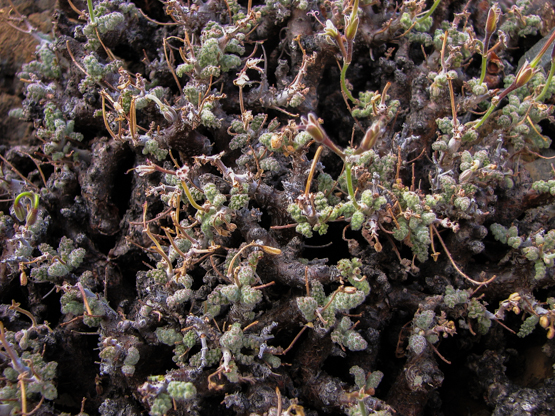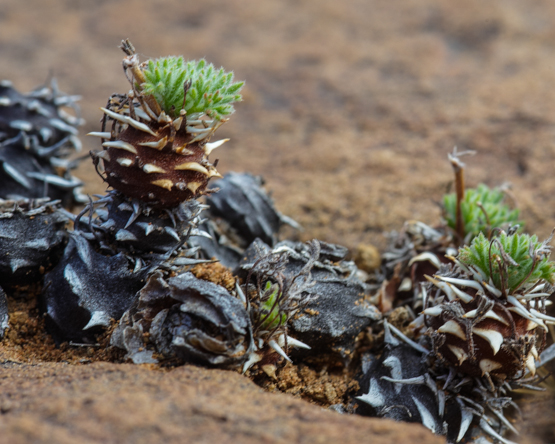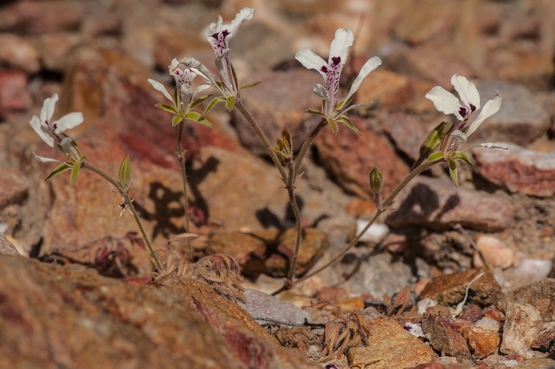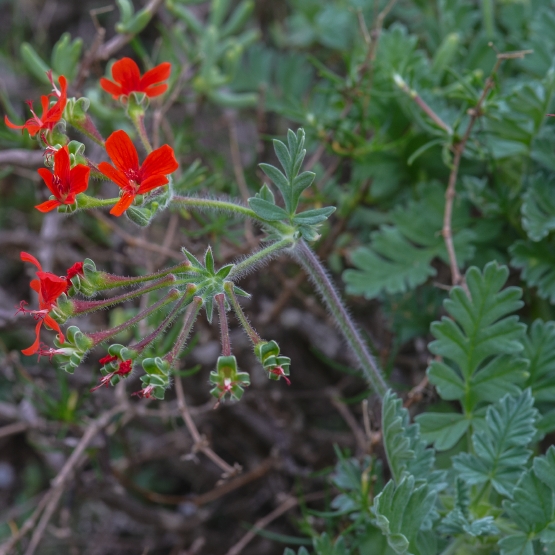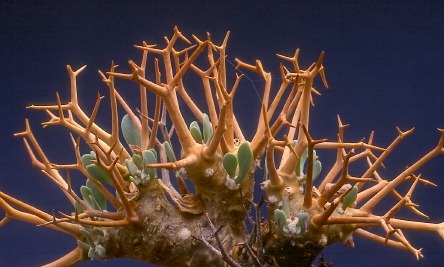This species occurs on both sides of the Orange River, from the Klinghardt Mountains in the northwest to Witputs in the east. With an annual rainfall of about 70 or 80 mm (occurring in winter) this is a very dry area. In many years there is even hardly any rain at all. The good news is that the meager amount of rain is supplemented by early morning mists throughout the year.
The plants grow on or against rocky outcrops, more or less in the open. They flower mainly between May and September.
Tag: Pelargonium
Pelargonium alternans (2)
Pelargonium alternans (1)
One can come across this species from the Bokkeveld Mountains to near Prince Albert on sandstone, shale and quartz slopes and outcrops. The rainfall in this area is between 100 and 200 mm a year, mainly during winter. Although the summers are very hot, there is often some frost in winter.
The plants may become up to 40-50 cm tall and wide and can apparently get very old. (See picture 4)
Flowering is mostly from April to January, but may occur at any time after rain.
Pelargonium hystrix (2)
Pelargonium hystrix (1)
Hystrix means porcupine in Greek and what a nice descriptive name that is for this plant. The stems are armed with spines, which in this case are in fact persistent stipules (outgrowths at the base of a leaf stalk).
The species occurs in the western part of the Karoo, from Calvinia in the north to Nougaspoort (halfway between Touwsrivier and Montagu) in the south. Usually the plants grow between and underneath bushes, sometimes in the open. The area receives mainly winter rain (100-200mm per year) and although it can become very hot in summer,
the winters are cool, usually with frost at night.
To be continued.
.
Pelargonium longifolium
Many of the more interesting Pelargoniums are geophytes*. The fact that they are hidden part of the year somehow adds to their appeal. The species shown here is very variable as to the shape and size of its leaves, which can be undivided or finely dissected and smooth or hairy. The beautiful flowers may be white, pale yellow or pink and appear from October to December.
The photos were taken last Saturday directly behind my house, where the plants grow in open or lightly vegetated sandy patches as well as on rocky outcrops. Actually the first ones I noticed were growing in an open Eucalytus coppice there.
* Plants which store water and/or food in underground storage organs and die down each year, regenerating at the start of the new growing season from buds that are hidden below soil-level.
Pelargonium fulgidum
Under cover; ways and means of conserving water
When looking at all those beautiful and unusual forms, colours and textures in succulents, it is easy to think that all this is there for our enjoyment. I’m afraid that is not the case; most of it is purely functional. For me, instead of being disappointing, this fact adds to my pleasure and admiration. What can be more likeable than things that are both useful and pleasing to the eye? In this post we will have a look at some of the contraptions that succulents use to conserve water.
The one thing that sets succulents apart from all other plants is their ability to store water that they can use during periods when there is no external supply. Obviously it is not much use to store a lot of water if you do not have the means to conserve it as well. Managing the stored water sparingly, mainly has to do with reducing transpiration.
The rate at which plants lose water by transpiration is influenced by a number of factors: size and form of the plant, temperature, humidity, intensity of sunlight, precipitation, wind speed, land slope etc.
On some days the temperature of the soil surface may rise as high as 75 degrees C, but a few centimetres higher up it will usually be much cooler (up to 40 degrees less ). The two extremes will be separated by a layer of still air.
Comparable layers with gradients of humidity and temperature are found above plant surfaces; they have a great influence on transpiration. These layers are disturbed or even destroyed by wind. Because of this, many succulents have a cover of hairs, spines, etc. on the surfaces of their leaves or stems. This helps in producing and protecting these layers. Such a cover also gives a certain shade and helps to diminish exposure to strong radiation –especially when it is light in colour. It has been found that tissue temperatures below spines of the cholla cactus (Opuntia bigelovii) can be reduced by as much as 11 degrees C.

In this Anacampseros albidiflora, short hairs on the leaves and long bristles between them, cooperate to keep the plant cool

Pelargonium barklyi is a tuberous plant. Although the leaves are short lived, it is apparently worthwhile to protect them with a cover of hairs

Haworthia arachnoidea gets its name from the spiderweb like cover of hairs. This variety is called scabrispina because the hairs are rough and hard like spines

In Senecio scaposus the leaves look like covered in felt
Many people think that spines are only there to protect the plants against browsing animals. In line with what we have discussed here, I think that spines play a certain role in that respect too, but that it is not the only, or even the most important, one.
In cases like Othonna euphorbioides (above) and Euphorbia stellispina -and in many other plants- the spines are actually hardened remains of inflorescences
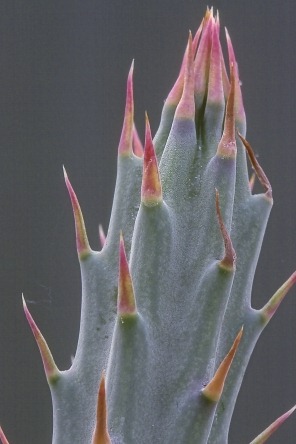
Leaf and stem surfaces are often thickened too, or coated with a layer of wax (Senecio stapeliiformis, on top) or cork (Othonna herrei)
A matter of colour (Pelargonium tetragonum)
The first time a saw a plant of Pelargonium tetragonum in the wild was in the vicinity of Calitzdorp. Later on I found out that the species was rather plentiful in the area, both north and south of the village.
The plants cannot be confused with any other species, but what surprised me was the colour of the flowers.
All the many plants I had seen in cultivation had pale pink flowers with deep red stripes on the upper two petals. All the plant I saw in the wild, not just around Calitzdorp but also elsewhere, had cream flowers (with the same red stripes as in the cultivated ones).
The more I thought about this phenomenon, the more I got the idea that the plants in cultivation originated from one or a few ancestors with an aberrant flower colour.
Last months I was in the Eastern Cape looking for plants with my wife and two Belgian plant friends. While trying to find my way into a dense thicket near Uitenhage, I suddenly came across several plants of this species with beautiful pink flowers.
So clearly the flower colour has to do with the area where the plants grow. According to J.J.A. van der Walt in “Pelargoniums of Southern Africa” (1977) the species occurs ” in a strip parallel with the coast from the Worcester-Caledon districts eastwards to Grahamstown. It has also been collected further inland near Graaff Reinet and Bedford”.
In their natural habitat the plants flower from September to December.




